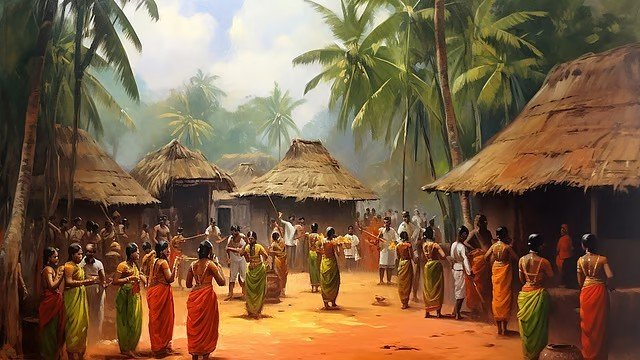Introduction
Long before the written word, India’s wisdom, values, and cultural memory were carried by the spoken voice. Storytelling was not merely entertainment; it was the heartbeat of community life, a way to preserve knowledge, teach morals, and strengthen identity. Whether through the chants of Vedic priests, the folk tales of village elders, or the epics recited by bards, storytelling has been central to Indian oral traditions for thousands of years. Even today, in the age of digital media, its legacy continues, showing how stories shape who we are and what we remember.
Ancient Roots of Oral Storytelling
The Vedas (c. 1500 BCE) were transmitted orally for centuries before being written down. Priests memorized and recited hymns with remarkable precision, ensuring accuracy across generations. This reliance on oral memory created a culture where listening and speaking were sacred acts.
The epics, the Ramayana and Mahabharata, further illustrate storytelling’s role. Bards known as kathakars recited these tales in villages and courts, weaving drama, music, and philosophy into performances that were both spiritual and communal. Their stories were not fixed but adapted, reflecting local dialects and values.
Folk Tales and Community Identity
Beyond religious texts, folk stories shaped the everyday imagination. Panchatantra fables, with their talking animals and moral lessons, were designed to educate children and rulers alike. Tales of Birbal in Akbar’s court or Tenali Raman in South India combined humor with wisdom, offering guidance wrapped in wit.
Tribal communities used storytelling to preserve ancestral histories, myths of origin, and ecological knowledge. In oral societies where literacy was limited, stories became living libraries, transmitting survival strategies, cultural memory, and social values.
Storytelling as Performance
In India, storytelling is rarely a solitary act. It is often a performance, accompanied by music, dance, or drama.
Kathakalakshepam (South India): Storytellers narrate epics while singing and playing instruments.
Pandavani (Chhattisgarh): A folk theatre form where performers dramatize the Mahabharata with song and gestures.
Puppetry traditions — from Rajasthan’s Kathputli to Karnataka’s shadow puppetry — use visual storytelling to captivate audiences.
These forms blur the line between art and ritual. Storytelling is both spiritual devotion and social entertainment, uniting communities in shared experience.
Moral and Spiritual Dimensions
Storytelling in Indian oral traditions has always had a didactic function. Stories from the Jataka Tales (Buddhist origin) emphasized compassion and selflessness, while the Hitopadesha reinforced practical wisdom. Hindu puranas narrated cosmic myths to explain moral order, while Sufi and Bhakti saints used parables to spread messages of love and devotion.
These stories were not abstract; they spoke to ordinary life. By embedding morals in narratives, oral traditions made ethical lessons accessible to all, regardless of literacy or social status.
Storytelling and Social Cohesion
Oral traditions helped reinforce community identity and social cohesion. Village storytellers gathered people in public spaces, creating collective experiences that bridged caste, class, and gender. Shared stories strengthened a sense of belonging.
Festivals often revolved around storytelling. The Ramlila of North India, a dramatic enactment of the Ramayana, continues to unite communities through weeks of performance, blending religion, theatre, and folklore.
Challenges in the Modern Age
With urbanization, technology, and mass media, traditional storytelling has declined in many regions. Oral forms face competition from television, films, and social media, which provide faster and more visual narratives. Many traditional storytellers struggle to sustain livelihoods, leading to fading practices.
However, the decline is not total. Modern platforms also revive traditions — YouTube channels, podcasts, and cultural festivals provide new spaces for storytellers. The essence of oral tradition — human connection through narrative — remains strong, though the medium evolves.
Counterpoint: Oral Traditions Still Alive
Critics argue that oral storytelling is dying, but in reality, it has adapted. The viral spread of stories on social media mirrors the oral tradition’s fluidity. Each retelling, whether through a tweet, meme, or short video, reshapes the story, much like kathakars did centuries ago. Oral storytelling survives because it is flexible, evolving with the times.
Global Influence of Indian Oral Traditions
Indian oral storytelling has influenced literature worldwide. The Panchatantra inspired Aesop’s fables, while tales from the Jataka spread across Asia with Buddhism. Today, diaspora communities keep traditions alive, narrating epics, folktales, and proverbs to younger generations abroad.
By blending oral traditions with global media, Indian storytelling continues to shape narratives far beyond its borders.
Conclusion
The role of storytelling in Indian oral traditions is profound. It has preserved sacred texts, transmitted moral lessons, united communities, and adapted to changing times. While the mediums may shift — from village gatherings to digital platforms — the essence remains: stories as vessels of memory, wisdom, and identity.
In India, storytelling is not just about the past; it is a bridge between generations, ensuring that values and voices are never lost. It reminds us that while technology may change how we tell stories, the human need for narrative — to teach, to connect, to inspire — will never fade.
References
UNESCO (2023). Intangible Cultural Heritage of Storytelling in India.
Blackburn, S. (2020). Oral Epics in India.
BBC Culture (2021). “How Indian Oral Traditions Survive in the Digital Age.”
The Hindu (2022). “Folk Storytelling Traditions and Their Modern Relevance.”
Ramanujan, A.K. (1991). Folktales from India.








